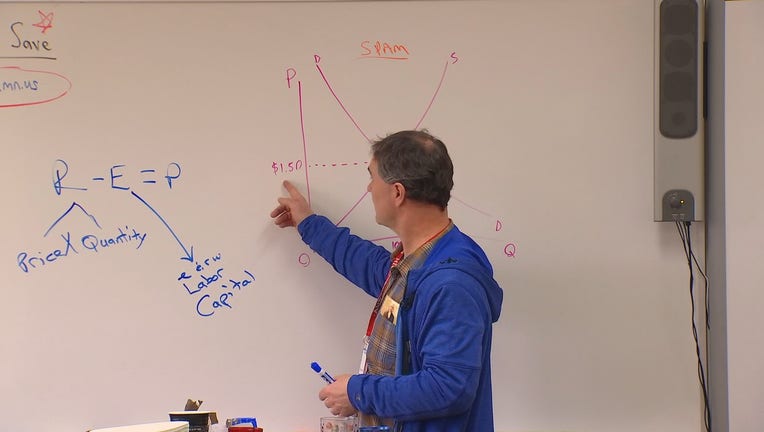Economics class at Austin High School full of lessons that hit close to home

Economics students in Austin, Minn. are learning about the economy through their own town's history.
AUSTIN, Minn. (FOX 9) - An economics class at Austin High School in Austin, Minn. is full of lessons learned from an iconic local business.
Rayce Hardy teaches the class: "We're stuck with a product that we can't raise the price on. You're the business owner what are you gonna do? Lay people off or pay them less?"

Economics class at Austin High School full of lessons that hit close to home
An economics class at Austin High School in Austin, Minn. is full of lessons learned from an iconic local business.
Every year Hardy teaches his students about Austin's Hormel strike of 1985. He knows it well because he lived it. Rayce's own father made the difficult decision to cross the picket lines and go back to work.
"Dad had 32 years into the company, he worked his way up to a top paid laborer and it was too much to give up," Hardy said.
The fallout from the 10-month strike was massive for Austin, both financially and socially.
Hardy says, "It's not as simple as I want this and you want this. It's much more than that. And then when you add that to this small town, where people go to the same church they go to the same grocery store their kids are in the same classrooms."
After the Hormel strike, many people left Austin and never came back. The city was forced to evolve. 35 years later you'd hardly recognize it.
Tom Stiehm, Austin's Mayor, says he gets that all the time.
"I have people say I'm from Austin I've been gone for 20 years. I can't believe what's happened to our town. And so I have to go, now they either love it or they hate it. And I get both of them," he said.
Before Stiehm was Austin's mayor he was a police officer there. He lived and worked through the strike and sees that time as a cultural tipping point for the city. He watched hundreds of immigrants and refugees move and take the jobs no one else wanted. "At that point we were 100 percent Caucasian now we're 23 percent refugee and probably 25-27 percent non-white."
These days, that diversity is alive and well on the streets of Austin and in the schools. Hardy says, "When I was a senior in this school there were three home languages and there are I think it's 46."
While the racial integration has been a success story, there's still a major socio-economic divide in Austin. Stiehm says, "If I could do one thing, wave a wand, I would like to see the wage gap taken care of and poverty rate go down."
The focus these days is making the local economy as diverse as its population and create better paying jobs.
Stiehm says, "We are a one horse town and we'd like to be a two horse town. And we'll keep working on it. or even a horse and a mule, ha."
And while Austin is still a town that looks over its shoulder, every year that passes there's a lot more to look forward to.
Hardy says, "There are scars but hopefully like with your body you heal and grow from things. And I think Austin is growing from it."

